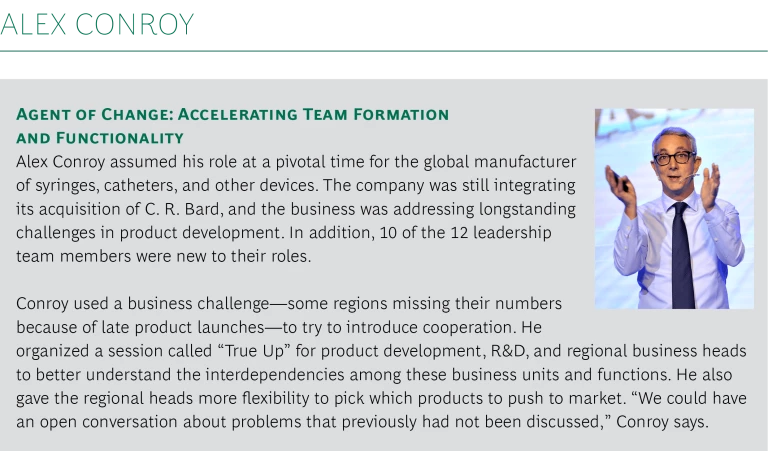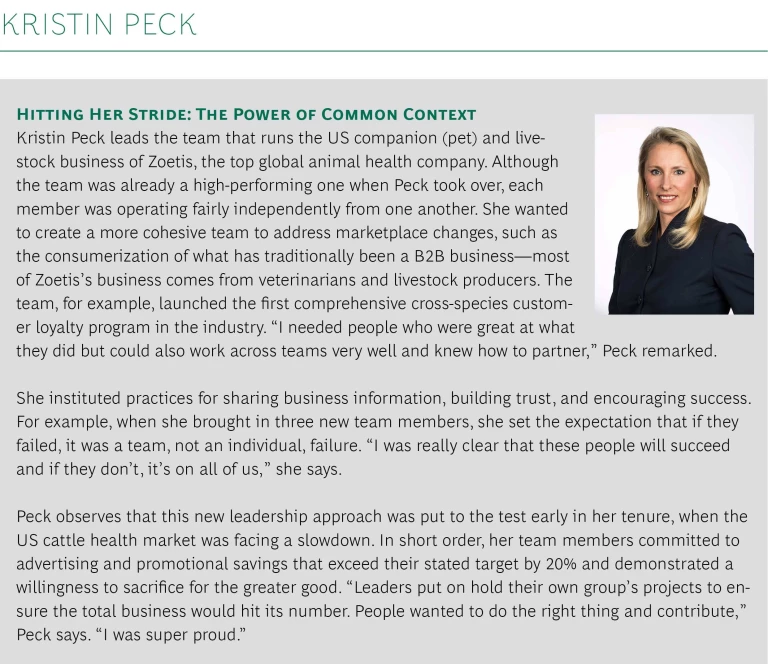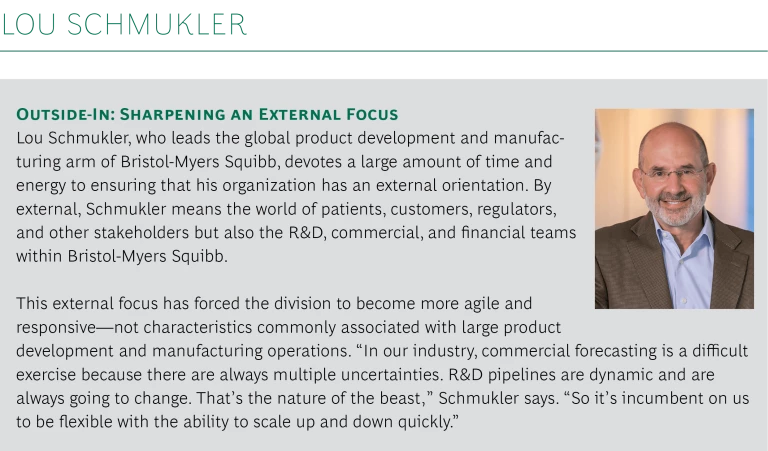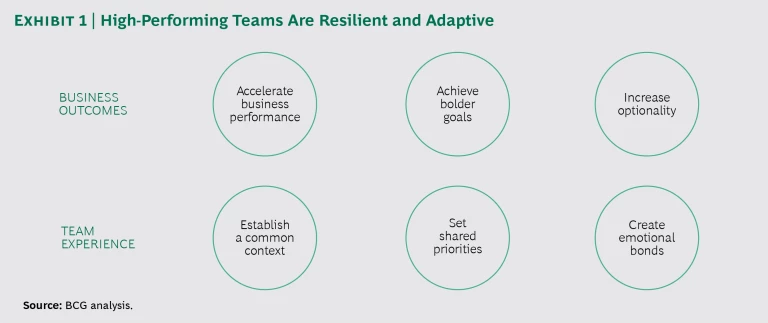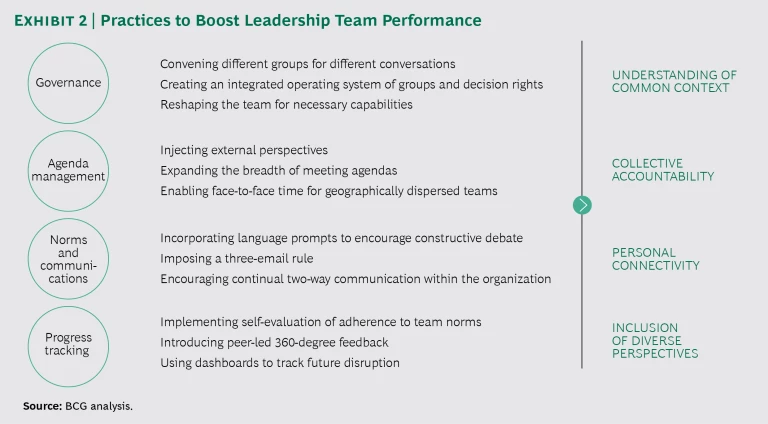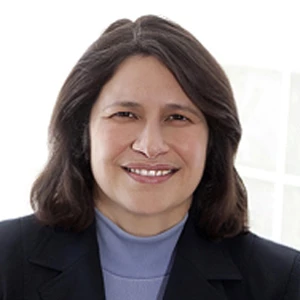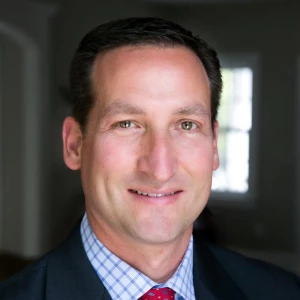Leadership “teams” often exist in form more than practice. Most teams meet several times a year, track progress, and set goals—and then individual leaders return to their business units or functions, where they believe their real work takes place.
This is a missed opportunity. Leadership teams that operate as actual teams are resilient and more adaptive. They accelerate business performance, achieve bolder goals, are more willing to experiment, and increase optionality—the pursuit of different paths and the ability to quickly change course.
In our work with leadership teams, we have discovered that the most effective teams come together to transcend the individual responsibilities of each member in four ways:
- Team members share a common language and understanding of the company’s business context—both headwinds and tailwinds.
- Team members are collectively accountable to one another, not just to the leader, for their performance.
- Team members have strong personal connections with one another that make them more willing to take risks, support one another, and celebrate successes.
- The team embraces diverse points of view, backgrounds, working styles, and ways of communication that go beyond traditional markers of diversity.
Rather than the traditional hub-and-spoke configuration, this leadership model is a web that derives strength from its inter-connections and commitments.
An Inside Look at the New Operating Model
Leaders play a critical role in setting aspirations and fostering this self-reinforcing environment. They do this through word and deed, instituting a discipline of practices that lay the foundation for a more productive team operating model. Later in this article, we identify a dozen representative examples of these practices that both energize the team and fuel business performance.
To demonstrate the effectiveness of the new leadership team operating model, we interviewed three leaders at different stages of their careers and different tenures (calculated at the time of the interviews, in late 2017) in the development of their leadership teams:
- Alex Conroy, president of Medication Delivery Solutions at Becton, Dickinson and Company (BD) for six months
- Kristin Peck, executive vice president and group president of U.S. Operations, Business Development and Strategy at Zoetis for two years
- Lou Schmukler, president of Global Product Development and Supply at Bristol-Myers Squibb for five years
You can read about these leaders in the accompanying sidebars.
Bolder Outcomes Through Broader Context, Priority Setting, and Connectivity
These three leaders want their teams trained on overall performance, not just the performance of each member’s business unit or function. They also want their leadership team to focus on the overall business context—business-shaping trends, the expectations of external stakeholders, and both traditional and nontraditional competitors. As Peck says, “I believe the external environment is evolving quickly. We need to raise our level of understanding of the future and strengthen our skills and capabilities continuously to build a sustainable competitive advantage while developing our next generation of leaders.”
This common context enables leadership teams to set team priorities rather than simply compile each member’s narrower priorities. Early in his tenure, for example, Conroy drafted a strategic narrative articulating three major themes—commercial excellence; innovation; and talent, culture, and team. The leadership team then rapidly identified key priorities for each theme and came up with execution plans. This clarity of purpose and priorities enabled much swifter follow-up action and results.
The three leaders want their teams to feel an emotional bond with one another.
Finally, the three leaders want their teams to feel an emotional bond with one another. That bond helps create trust and confidence and makes members more willing to both support and challenge one another. (See Exhibit 1.)
When one of Peck’s team members scheduled a workshop with employees in the middle of a difficult restructuring, fellow leadership team members went out of their way to attend the meeting and actively participate in group breakouts to visibly demonstrate their support for the changes. “I think that gave him confidence,” Peck says. “The team and team members feel everyone is behind them and have their back during tough times, and are cheering for them in good times.”
Tracking the Changes
What gets measured gets done. These leaders relied on the BCG Adaptive Leadership Teams Survey to determine whether they were actually changing their behavior in order to improve their team operating models and increase business value. (To request a copy of BCG’s Adaptive Leadership Teams Survey, send an email to altsurvey@bcg.com.)
Their survey results show that the teams are effective at communicating quickly and effectively, listening to diverse stakeholders, and aligning values, objectives, and priorities. At least 80% of members on all three teams agreed with these statements about their own teams.
Surveys helped leaders to determine where they’ve been successful and where they still have more work to do.
But all three teams have more work left to do. On each team, fewer than half of the members agreed that they are sanctioned when they do not cooperate with one another. Fewer than two-thirds of members agreed that their colleagues are, in the words of the survey, “utility players who can play out of position and pinch-hit for others.” These gaps can limit the development of a common context and shared responsibility.
Early in Peck’s tenure, a challenging rollout of a new IT system project provided her team with an opportunity to come together and more fully understand one another’s roles. “I inherited a team of people who each did their job exceedingly well, including a sales force that either hit or beat their numbers. But I wanted to build stronger alignment and common purpose,” Peck remarks. During the system’s rollout, “It was all hands on deck every morning, and we quickly learned where we had linkages and accountability among team members and where we did not,” she says.
Doing Things Differently
The three leaders we interviewed have consciously committed to practices that are different from those associated with a traditional hub-and-spoke model in order to strengthen context, accountability, connectivity, and diversity. (See Exhibit 2.) We have organized these practices into four categories, although many of the practices apply in more than one category.
- Governance. Formal design of roles and accountabilities.
- Agenda Management. Meeting cadence and topics.
- Norms and Communications. Rules of engagement within the team and with other stakeholders.
- Progress Tracking. Metrics of success for the leadership team and the business.
We review some of the more intriguing and insightful practices of these leaders and others we have worked with over the years.
Governance
Governance should be a dynamic, fluid, and fast-moving endeavor, not a dry exercise.
Convening Different Groups for Different Conversations. Leaders should be deliberate about bringing together the right people for the right meetings to enable more focused deliberations and decisions and to allocate time more efficiently.
Peck’s longer-term-strategy team meets quarterly, while her operational group meets once a month. On Fridays, a smaller group comprising just Peck and the heads of finance, operations, and the three business units have a 45-minute “huddle” call on the competitive landscape and business signals that could influence performance. “The goal is an ‘inform’ call, not a discussion. If there needs to be a discussion, we take it off the call,” Peck adds.
Creating an Integrated Operating System of Groups and Decision Rights. A leadership team should be equally deliberate about deciding who is responsible for what. When Conroy arrived in his new job, for example, many key innovation and product development decisions had been delegated and decentralized in an effort to empower lower levels of the organization. But, Conroy says, the result was that the global-leadership team was a bystander in key strategic decisions.
Conroy adapted the global-governance model to make product development and innovation a much larger part of his leadership team’s agenda. Global functional leaders became more deeply involved in key projects, and overall collaboration on product launches among regional businesses, functions, and global platforms improved measurably. “The accountability of the whole leadership team around product development is much better,” Conroy comments.
Conroy publishes the agenda of his leadership team meetings in advance, and executives who are not members can attend without an invitation. This open-meeting practice allows Conroy to limit the size of the leadership team while ensuring that other executives stay involved.
Reshaping the Team for Necessary Capabilities. To stay ahead of external developments and strategic shifts, leaders often need to reshape their teams. They don’t necessarily have to change the team’s composition. Members frequently have latent strengths, connections, and experiences from prior roles, organizations, and outside activities. Sharing a comprehensive catalogue of members’ professional and life experiences can help the team recognize the value of diversity of thought, background, and belief and allow it to tap into these strengths.
At times, teams need to inject new expertise or an outside perspective. Schmukler’s team, for example, has gradually changed members and redefined roles to align with strategy and context. “Our company strategy, business dynamics, and the external environment are factors that we consider for the leadership team’s composition,” Schmukler says. “I believe not paying close attention to this is often the reason leaders and their teams fail.”
Agenda Management
Thoughtful approaches to meeting topics, frequency, and efficiency can pay unexpected dividends as well as boost engagement and energy among team members.
Injecting External Perspectives. To counteract the natural tendency of leadership teams to become internally focused, leaders should try to expose their teams to the larger outside environment. Conroy and his global-leadership team recently attended the American Society of Health-System Pharmacists meeting. The trip gave the team a shared reference point, which is more powerful than a single member reporting back on his or her experience at the meeting. “It was a great way to show that we wanted to be more customer and externally focused as a team,” Conroy says.
Some leadership teams encourage each member to write a quarterly memo on how external events affect their own unit and those of other team members. The team then circulates and discusses these memos and considers whether they should adjust their short- and long-term ambitions.
Expanding the Breadth of Meeting Agendas. Rather than focusing narrowly on immediate business issues and performance, the three leaders elevate the agenda of their meetings by routinely diving into talent and other critical longer-term issues. “We have become much more externally focused, and we also strive to strike the right balance between time spent on strategy and running the business,” Schmukler remarks. “People and culture topics such as talent management, diversity and inclusion, leadership capabilities, and succession planning are also a significant part of the team’s agenda.”
At each monthly operational meeting, Peck’s leadership team examines the talent profiles, performance, and potential of two senior leaders in the organization who are not on the team. These discussions help raise the visibility of individuals across the team so that members have a shared sense of talent development, resulting in higher-quality succession and job placement decisions.
Other teams deliberately share stories of embarrassing professional moments to promote camaraderie. When peers let their guard down and find humor in once-painful situations, they are more likely to be relaxed and open to cooperation.
Teams use dashboards to track future disruptions.
Peck accomplished a similar aim by sending her direct reports a brief memo titled “12 Things That You Need to Know About Working for Kristin.” The memo short-circuited the traditional guessing game associated with understanding the expectations and leadership style of a new leader.
Enabling Face-to-Face Time for Geographically Dispersed Teams. Schmukler gathers his global-leadership team every month for a day and a half. In addition to attending the leadership meeting, members are required to be in the office for the entire week so that follow-up face-to-face meetings can occur. This unstructured time together provides opportunities for smaller groups to strengthen emotional bonds, work cooperatively, and accelerate execution and decision making.
Schmukler also places a premium on the overall efficiency and effectiveness of team meetings. One simple example is limiting full-day meetings. “I think all-day management team meetings are often challenging. They can be draining, with the first half highly productive, the second half not as much; I believe there is research that supports this,” Schmukler says.
Norms and Communications
The way a leadership team treats, talks to, and communicates with one another sets the context for members’ willingness to cooperate and take risks.
Incorporating Language Prompts to Encourage Constructive Debate. Schmukler and his team wanted more candid dialogue on challenging topics, so they put a placemat in front of each team member printed with language prompts such as, “Let me recap to ensure I understand your point,” “I think I see things differently. Let me describe how,” and “You mentioned [fill in the blank]. What assumptions did you consider?” This exercise helps to surface disagreements that stem from team members having different perspectives or sets of facts.
Imposing a Three-Email Rule. Leaders should articulate clear expectations about how to communicate with one another. Peck, for example, asks that her team members talk live or schedule a meeting if an email exchange lasts too long. “If it requires more than three emails, it requires a call or a meeting,” Peck says. She has the same expectation if a topic is likely to be contentious or emotional. “When you are upset, pick up the phone. It is hard to read tone in emails,” she points out.
Encouraging Continual Two-Way Communication Within the Organization. At Zoetis’s US business, communication within the leadership team and from the team to the larger organization is a multifaceted and thoughtful undertaking. Peck and her team overinvest in deciding, depending on the subject, who should be the messenger and in determining the best method of delivery. “Everyone processes in very different ways, so you have to try different channels—email, town halls, internal social platforms, and videos,” Peck says. “I think communication and alignment are two of the hardest things leaders have to do.”
Some leadership teams have started to rely on two-way communication tools to interact with the front line. These tools, such as the Tuned by BCG app, are the business version of crowdsourcing and, if used the right way, provide an alternative and complementary means of receiving feedback, unearthing barriers to change, and communicating real-time updates. (For more information on how to use Tuned by BCG to improve engagement in an organization, send an email to tuned@bcg.com.)
Progress Tracking
Leadership teams should track and benchmark not just their financial and operational performance but also their adaptive capacity and their commitments to one another as a team.
Implementing Self-Evaluation of Adherence to Team Norms. The members of Schmukler’s team at Bristol-Myers Squibb grade themselves each quarter on their behavior and adherence to team norms. “If you say this is important and say you are going to hold everyone and yourself accountable, then you need to do that,” Schmukler remarks. “Otherwise you lose credibility as a leader, and the team may say, ‘I guess that really wasn’t that important for him.’”
At BD, Conroy plans to conduct a similar exercise annually. His team has also started to give out awards based on culture and behavior.
Introducing Peer-Led 360-Degree Feedback. A slight variation of this theme is to have members of the leadership team conduct peer-led 360-degree feedback sessions. When team members analyze their peers’ performance and communicate this feedback to their colleagues, they gain a much richer sense of that individual’s context, strengths, and weaknesses. At other companies that have conducted similar feedback sessions, we’ve observed an increase in both empathy and willingness to ask for and extend help to peers.
Using Dashboards to Track Future Disruption. Peck’s team actively monitors external signals, such as the futures price of cattle and the number of monthly vet visits, through several dashboards in addition to more traditional internal metrics. The dashboards are part of the team’s increased external focus since Peck’s arrival. “The environment was evolving really quickly. We needed to raise the level of understanding of where the future was going,” Peck says.
A new dashboard, just launched in January, tracks customer experience. All members of her team receive this feedback, even if they don’t deal directly with customers. The dashboard and other communications, for example, might alert manufacturing that a competitor is having a problem that could require an increase in production. “We have shared accountability for supply and demand,” Peck comments. “If the supply plan is off, we have to ask ourselves whether our demand forecast was accurate.”
Conroy’s team has also been improving its ability to sense external signals through a scorecard. “The sensing mechanism is obviously much better,” Conroy notes. “We drive a better response and clearly synthesize a lot of information there.”
Evolution of the Team Leader
The three leaders all say they personally aspire to be bolder, faster, and more agile as well as more transparent and cooperative. The surveys completed by their team members, however, reveal that the companies do not always embrace innovation and experimentation, and findings suggest that the leadership teams could act more swiftly and more boldly in response to changing market conditions. At the same time, the leaders say—and the same surveys confirm—that they are better listeners and are more willing to share information and authority, consider diverse opinions, and address team tensions in real time.
The three leaders all aspire to be bolder, faster, and more agile.
Still new in his role, Conroy has already sharpened his own approach to finding solutions more quickly. “We can mobilize resources around solving issues in a way that was not the case before,” he says.
Peck, whose team has been together longer than Conroy’s, indicates that the level of trust among her leadership team allows her to be a steadier and more collaborative leader. “Even when things go wrong, my level of trust and positive intent is very strong, and that allows me to focus on creating optionality versus placing blame,” Peck says.
The longest-tenured leader in his current role, Schmukler, notes that he has “gotten better at delegating and empowering.” In fact, one of his proudest moments as a leader came last year when Hurricane Maria tore through Puerto Rico, where Bristol-Myers Squibb has critical manufacturing operations. His team encouraged him to provide guidance and support but otherwise to let local managers lead. “When you know that the stakes are high and that failure is not an option, that can be a moment of truth for a leader and a teachable moment when you have a chance to really walk your talk,” Schmukler remarks.
Most of all, the three leaders believe that they have achieved or aspire to achieve stronger performances, reach higher goals, and create greater optionality. In 2017, for example, Zoetis’s US business grew by 7%, faster than the market. Peck credits her team’s performance to many of its new leadership practices and the “ability to create optionality, flexibility, and agility.”
Putting New Team Leadership into Practice
Despite their differences in tenure, experiences, and roles, Conroy, Peck, and Schmukler share a belief that traditional leadership models are out of date. They have deliberately chosen to move away from a hub-and-spoke configuration and toward a more distributed and agile team operating approach.
Other leaders looking to raise performance, make bolder moves, and improve optionality may want to test some of the practices that these three leaders have deployed—or develop their own. The difference between the old and the new leadership models is the difference between addition and multiplication. You get a bigger and faster boost from multiplication.

